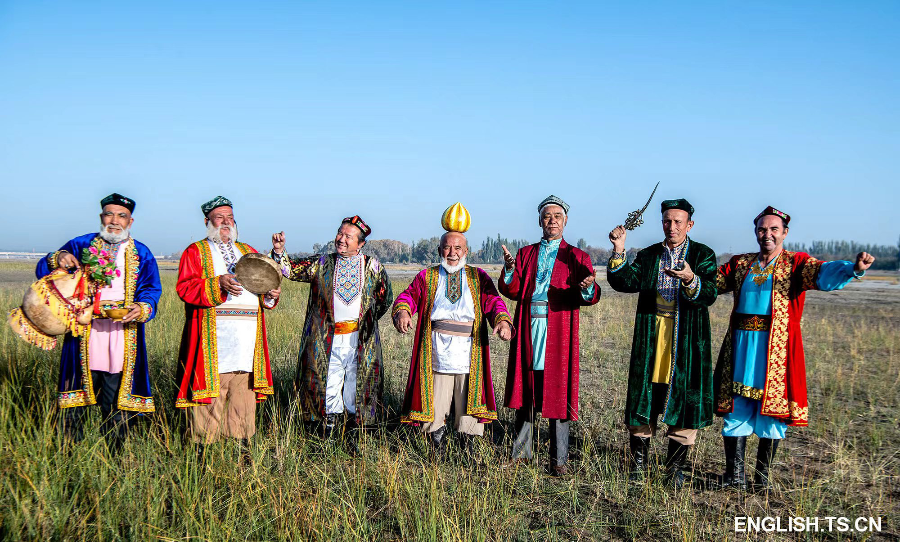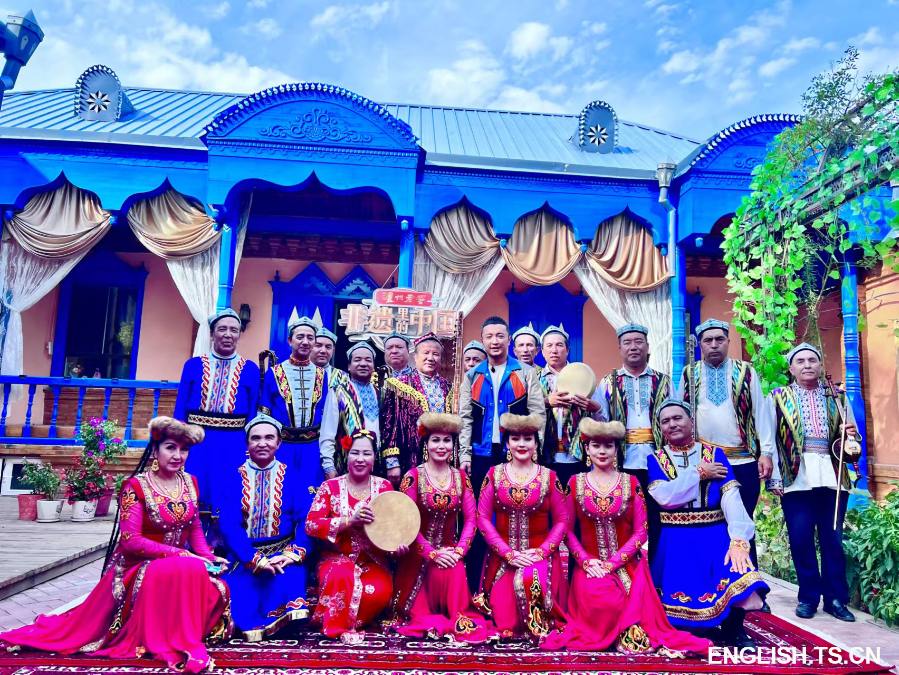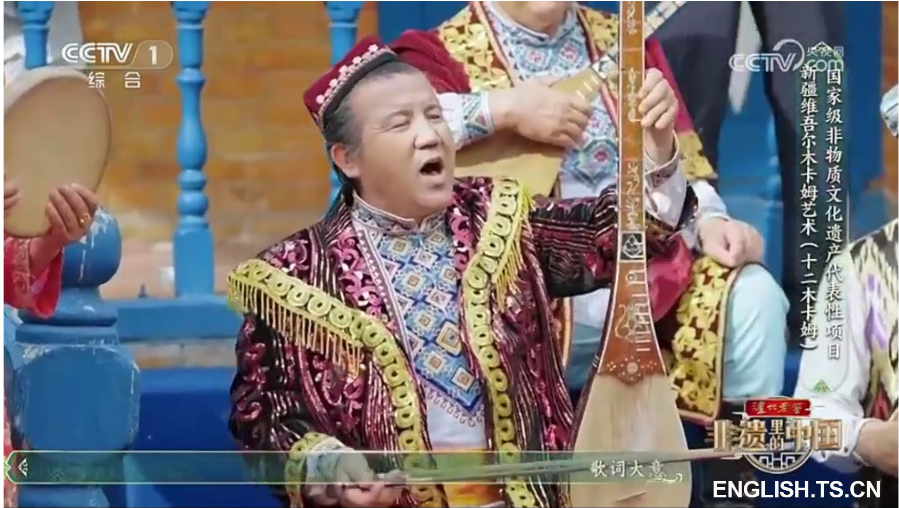Tianshannet-Xinjiang Daily (Reporter Song Haibo) news: “My body and mind are ablaze under the sun. Within my heart the sun ignites. How can I invite the stars to come closer to my side...” Yilihamu Reyimu sat on the ground, holding a satar (a stringed instrument) in his hand and plucking the strings. As the music flowed out, the actors danced merrily. At 8 p.m. on November 24, in the program The Intangible Cultural Heritage in China aired on CCTV-1, Yilihamu, as a region-level representative inheritor of the Twelve Muqam (a kind of Uygur Muqam art), is playing the satar and singing with emotions, as energetic as a teenage boy who will never age.

Yilihamu (third from left) takes a photo with the actors. (Photo provided by Yilihamu Reyimu)
“Twelve Muqam is unique for it incorporates literature, music, dance, rap and other diverse art forms. It was the fruit of the collision and integration of cultures on the ancient Silk Road,” said the gray-haired Yilihamu, and his eyes brightened with passion and youthful vigor. For hundreds of years, Twelve Muqam has blossomed in the land of Xinjiang, and been passed down from generation to generation.
Born into a family of folk artists, Yilihamu studied Twelve Muqam from his elders since he was a child. “My grandfather and father both worked in professional troupes. My father asked me and my brothers to learn musical instruments, and my sisters to learn dance. During the winter and summer vacations, grandfather would take us to the countryside to learn.” Thanks to the good environment for art education, Yilihamu developed strong interest in Twelve Muqam since his childhood.
Back then, Yilihamu spent a lot of time with his brothers and sisters, playing instruments and dancing. He never got tired of it. He and his family also formed a family ensemble, and often performed for guests from afar.
His hard work paid off. At the age of 15, Yilihamu took to the stage for the first time to perform Twelve Muqam. He was ecstatic on stage. “I listened to the music and danced. I did not want to stop. I really enjoyed the feeling of performing the Twelve Muqam on stage,” said he.
In 1978, the 16-year-old Yilihamu was recruited into the Shache County Art Troupe. He said, “In less than two decades with the county art troupe, I performed only Twelve Muqam. For me, it is the embodiment of spirit, a profound essence, and an invaluable artistic treasure.”

Yilihamu participates in the recording of the program "The Intangible Cultural Heritage in China". (Photo provided by Yilihamu Reyimu)
Each of the 12 musical compositions consists of three parts: Cong Naghma, Dastan and Meshrep. Cong Naghma sings about the people’s spiritual pursuits. Dastan uses music to tell stories, including the tragic love stories, stories about tragic heroes, and beautiful poems of the Uygur people since ancient times. Meshrep is the climax of joy, where people sing and dance to the repetitive melody. Each musical composition contains 20 to 30 melodies, and it takes about 24 hours to perform the Twelve Muqam in its entirety.
Many years ago, when Yilihamu traveled around to perform Twelve Muqam, he found that most of the performances were limited to only two parts: Dastan and Meshrep, and the Cong Naghma part was rare to hear. After consulting with well-known local folk artists, they decided to form a Twelve Muqam band and learn from each other. Whenever they were free, they would play and learn together in some teahouse or cool farmhouse. Yilihamu also collected 4,500 lines of Twelve Muqam of various tunes, and made additions and updates on the basis of the original repertoire.
To make it easier for folk artists to understand the complex form of Twelve Muqam notation and familiarize with the beatmap, Yilihamu replaced the traditional teaching method with demonstration teaching. “I would do the demonstration with playing and singing while they play and follow along using their familiar instruments. This is the most effective and fast way to learn. Through our training, some folk artists can now play the complete Twelve Muqam,” said he.
“In 2003, the government launched the nomination of Uygur Muqam of Xinjiang as a UNESCO Masterpiece of the Oral and Intangible Heritage of Humanity. At that time, I formed the Twelve Muqam Inheritance Society, and many folk artists came to learn the art,” said Yilihamu.
In 2005, the Uygur Muqam of Xinjiang was proclaimed by UNESCO as a Masterpiece of the Oral and Intangible Heritage of Humanity. “When I learned the news, tears welled up in my eyes. This is a recognition and support for our Chinese culture. I am determined to do a good job in inheriting the art and take the Twelve Muqam art further.” He added that in recent years, Xinjiang has set up many Twelve Muqam inheritance centers to promote exchanges between folk artists.
Nowadays, an increasing number of people nationwide, regardless of their profession, are learning Twelve Muqam. These include seven- and eight-year-olds, as well as people in their 70s.
Nusilaibu Wubuli is a farmer in Yingwusitang Township, Shache. She spent 10 years learning Twelve Muqam from Yilihamu. Recalling the early days of learning, she said, “When I first started playing Rawap, I was shy and timid. The teacher encouraged me to play boldly. Now, I can not only skillfully play multiple instruments, but also do most of the dance moves.”
Wang Xinzu, a former dentist in Korla City, has been learning Twelve Muqam since he retired. “The language is the biggest barrier for me. Teacher Yilihamu joked with me after class that learning Twelve Muqam is like pulling out a tooth; you cannot rush it. Now I can sing and play several songs at the same time.”
How can traditional art maintain its vitality in today’s world? In Yilihamu’s view, the inheritors of intangible cultural heritage should not be confined to the old ways, but should seek innovation while upholding fundamental principles. “We tried to adapt Twelve Muqam into a stage play. We re-arranged the easy-to-understand parts so that the audience can have a rough idea about what Twelve Muqam is and appreciate its beauty.”

Yilihamu performs a segment in the program "The Intangible Cultural Heritage in China". (Video snapshot)
In addition, Yilihamu also made full use of short videos to introduce Twelve Muqam to more people. “I opened an account on Douyin(the Chinese version of TikTok) called ‘Twelve Muqam and Inheritance – Yilihamu’, which has 53,000 followers. Next year, the newly built Yilihamu Intangible Cultural Heritage Hall (Twelve Muqam Inheritance Center) will be opened. I will invite artists to perform Twelve Muqam, and do live-streaming sessions to introduce the art to more people,” said he.
“I never forget my responsibility of cultivating more inheritors.” As an inheritor, Yilihamu always carries a heavy responsibility on his shoulders. “I will devote my life to promoting Twelve Muqam, so that more people will understand and enjoy it.”









